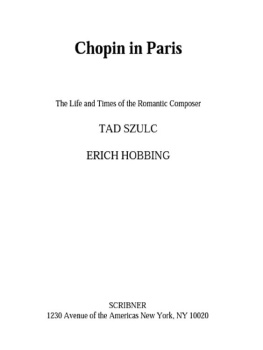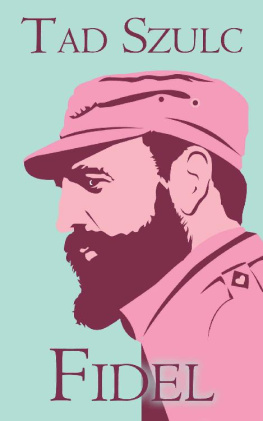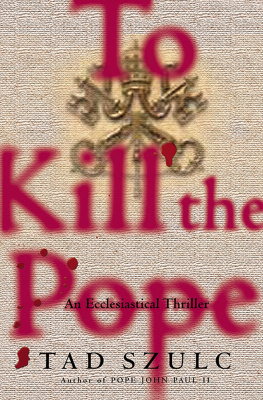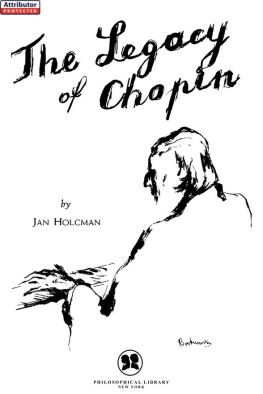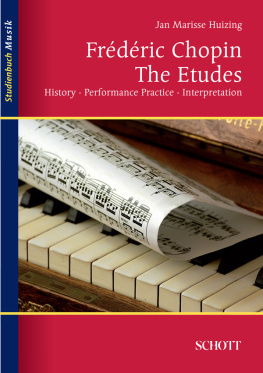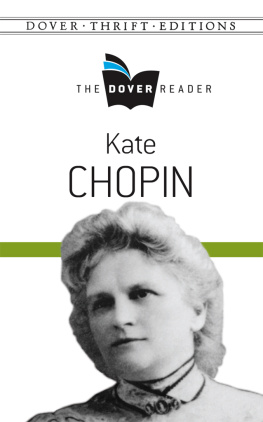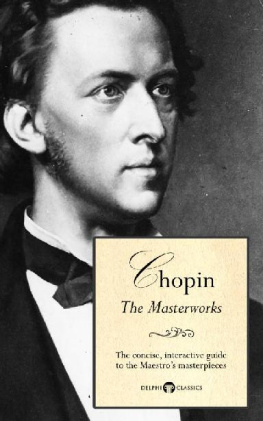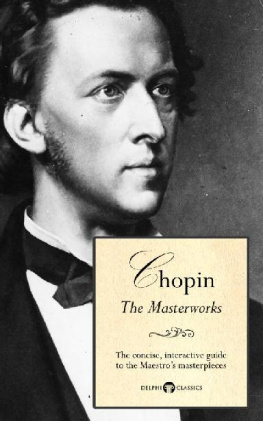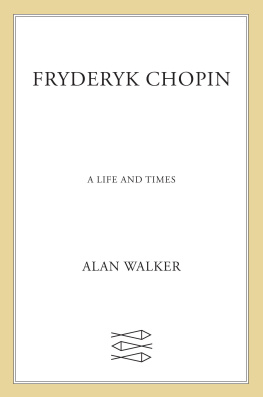Chopin in Paris
The Life and Times of the Romantic Composer
TAD SZULC
ERICH HOBBING
SCRIBNER
1230 Avenue of the Americas New York, NY 10020

B Y THE S AME A UTHOR
Twilight of Tyrants
The Cuban Invasion (with Karl E. Meyer)
The Winds of Revolution
Dominican Diary
Latin America
The Bombs of Palomares
Portrait of Spain
Czechoslovakia Since World War II
Innocents at Home
The United States and the Caribbean (editor)
Compulsive Spy
The Energy Crisis
The Illusion of Peace
Diplomatic Immunity (a novel)
Fidel: A Critical Portrait
Then and Now: How the World Has Changed Since World War II
The Secret Alliance
Pope John Paul II: The Biography

A LISA DREW BOOK/SCRIBNER
1230 Avenue of the Americas
New York, NY 10020
www.SimonandSchuster.com
Visit us on the World Wide Web: http://www.SimonSays.com
Copyright 1998 by Tad Szulc
All rights reserved, including the right of reproduction in whole or in part in any form.
SCRIBNER and design are trademarks of Simon & Schuster Inc.
A LISA DREW BOOK is a trademark of Simon & Schuster Inc.
Set in Adobe Garamond
DESIGNED BY ERICH HOBBING
ISBN 0-684-86738-9
eISBN: 978-0-684-86738-0
This book is in memory of my grandfather B ERNARD B ARUCH , a Warsaw amateur pianist
Contents
Preface
F RYDERYK C HOPIN EXPRESSED everything he had to say to the world through his music, according to one of the most eminent performers of his works, and this unquestionably is true. The depth and the breadth of his creation is extraordinary, from love to furious anger, from joy to endless sadness and melancholy, from tenderness to pride and defiance. Its beauty and enchantment are supreme. Unpredictability and mystery are, of course, part of art, and his compositions are rich in them and ever surprising to the listener. He was, by contemporary accounts, one of the greatest and most innovative pianists of the nineteenth century. And, finally, he was a splendid teacher.
Chopins music was admired, analyzed, applauded, compared, critiqued, criticized, described, discussed, dissected, examined, and judged to an exhaustive extent even before he died at the age of thirty-nine a century and half ago, and the fascination has continued ever since. Timeless, it arouses, bewitches, caresses, and charms today as it did at its first hearing.
What Chopins music says about him (and whether it does so at all) is an impossible and probably idle philosophical, psychological, and aesthetic question. Few specific compositions, if any, seem to reflect his mood or the state of his health at the particular moment of creationadd to that the fact that often we have no exact dates for the completion of a given work and only know that sometimes years elapsed between the start and finish of a composition. Some of the merrier, upbeat mazurkas and polonaises, for example, were conceived when he was believed to be quite ill and/or depressedwhile sad, wistful nocturnes and ballades were written when he was thought to be well and at his amusing and playful best. Then there are tudes and prludes, in the same cycle, wholly distinct from others in mood.
A private individual, Chopin was the least helpful in unveiling the mysteries of creationor the mysteries with which he chose to surround himself. Who, then, was Fryderyk Chopin?
My fascination with this man of genius provided the overwhelming reason for writing this book. I wanted to present in an entirely new lightoften in his own words and words of those close to himthis immensely complex man, his time, joys, frustrations and tragedies, hopes and defeats, illusions and hallucinations, and the frightening physical and mental suffering he bore.
That Chopin was a genius, that he was both part of the breakthrough Romantic movement in the arts and a romantic figure in his own righthe was loved by a succession of extraordinary women, first and foremost George Sandand that he regarded himself as an ardent Polish patriot when his homeland was under brutal foreign occupation, have long been the stuff of the Chopin legend. In a literal sense, it was all true. It was also true that he had displayed astonishing courage, discipline, and willpoweras well as a very special brand of quiet, self-deprecating humorin fighting to the very end the terrible illness that destroyed him.
Uncounted millions of words in Polish, French, English, and many other languages were written about Chopin in newspapers, magazines, books, and encyclopedias of the day, and memoirs and letters from as early as the 1830s, when he first set foot, barely twenty-one years old, in Paris, determined to conquer. More than a century and half later, however, he remains an elusive personage.
I have always felt that the human dimension was missing, that I could not really understand the man. So, rather than embark on a standard birth-to-death biography, I decided to concentrate on the eighteen years Chopin lived in France, or nearly half his life, because this was both musically and personally his richest (and would prove most mature) period, when he lived side by side with the most remarkable creative men and women of the century. It offered a unique cast of magnificent charactersthe people Chopin had befriended, those with whom he had associated professionally. And I believe that the artistic, personal, and political closeness of his circle (never replicated anywhere else to the best of my knowledge) played a crucial role in fashioning the quality and scope of culture of that era in Europe: Sand, Balzac, Hugo, Lamartine, Delacroix, and Heine; Franchomme, Liszt, Berlioz, Schumann, Mendelssohn, Bellini, and Rossinias well as the Rothschild bankers. They were all among Chopins friends and acquaintances; even Karl Marx was on the periphery. And Chopin in Paris represents an effort to grasp that human dimension.
To command a sense of Paris in Chopins time, I visited the eight locations where he had lived between 1831 and 1849. With the exception of one location on the Chausse dAntin and the house in Chaillot, they remain exactly as they were in his day; Paris does not change very much. Square dOrlans, where he lived the longest, looks today just as it did in the 1840s, to judge from contemporary sketches and drawings. The building on place Vendme, where he died, is unchanged (though the address now faces the Ritz, opposite). Le grand sicle de Paris by Andr Castelot, La curieuse aventure des boulevards extrieurs by Jean ValmyBaysse, Listening in Paris by James H. Johnson, and The Love Affair as a Work of Art by Dan Hofstadter added to my knowledge of Parisian life and culture at the time. About Nohant, which I visited during my research in France, I found Chopin chez George Sand NohantChronique de sept ts by Sylvie Delaigue-Moins to be immensely helpful. Nohant, two hundred miles south of Paris, was Sands country home.
I went to Zelazowa Wola near Warsaw, Chopins birthplace, and to the monastery of Valldemosa in Majorca, where Chopin and Sand spent five horrid months, years before I conceived the idea of writing the composers biography. But the images remained clear in my memory. Chopins Warsaw (partly rebuilt after World War II) is basically unchanged in appearance although the Saxon Palace is gone. Vienna is still Vienna. In London, two out of the three buildings where Chopin lived are still very much there.

